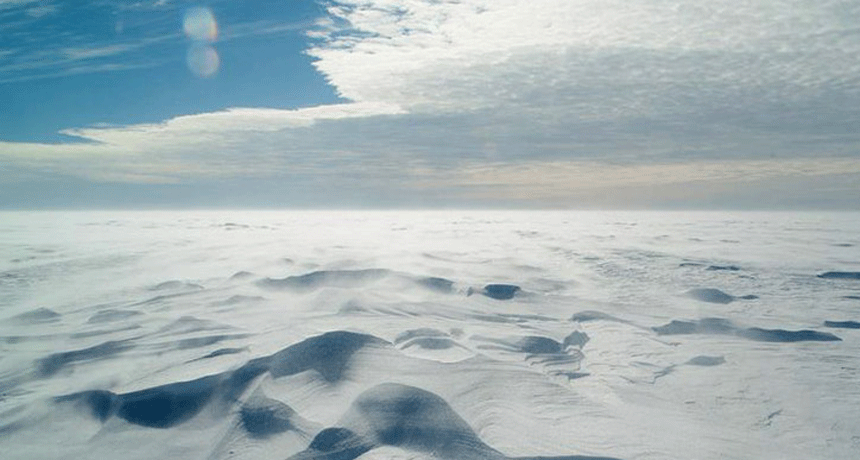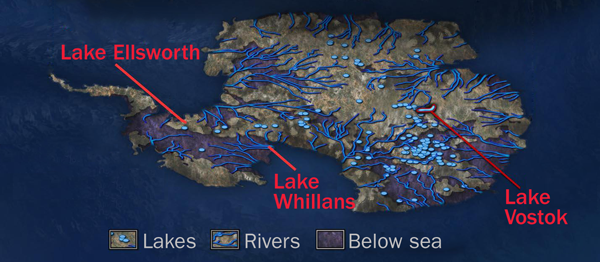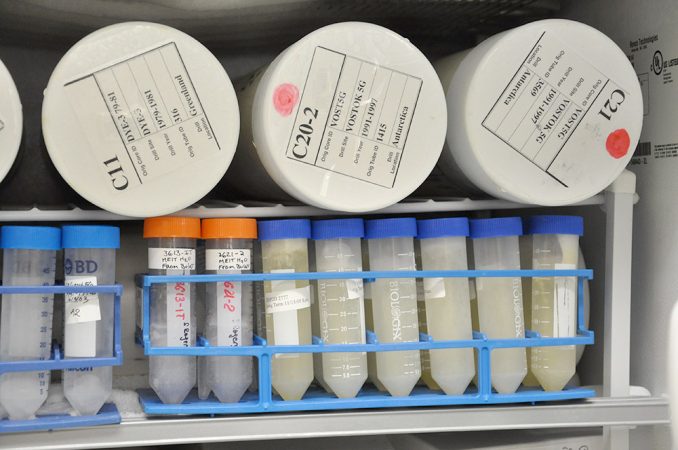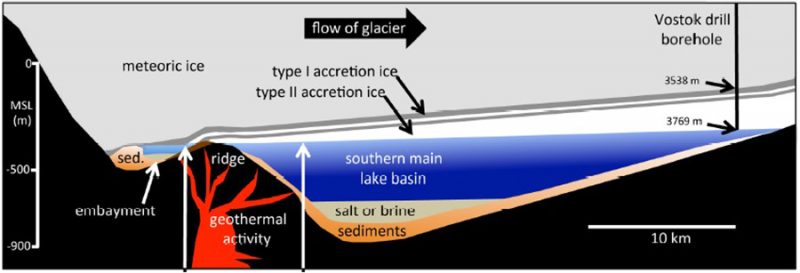Animals under Antarctic ice?
Data suggest a web of lake organisms might thrive deep under ice; scientists struggle to make sense of the new report

The surface of Antarctica’s ice sheet is a harsh polar desert. During summer it is raked by the sun’s damaging ultraviolet rays. In winter, temperatures can fall below ‒80 degrees Celsius. But kilometers below sits a network of rivers and lakes, including Lake Vostok. New evidence finds life in these buried waters, but scientists are still debating what types and how much life they may hold.
JT THOMAS
Share this:
- Share via email (Opens in new window) Email
- Click to share on Facebook (Opens in new window) Facebook
- Click to share on X (Opens in new window) X
- Click to share on Pinterest (Opens in new window) Pinterest
- Click to share on Reddit (Opens in new window) Reddit
- Share to Google Classroom (Opens in new window) Google Classroom
- Click to print (Opens in new window) Print
By Douglas Fox
Lake Vostok is the seventh-largest lake on Earth. It is also the fourth deepest. Although it was discovered more than 20 years ago, humans have never laid eyes on it. And that’s because it lies beneath 3.7 kilometers (2.3 miles) of ice in the center of Antarctica. But its remote site has not kept scientists from trying to probe this lake and whatever it may hide. And if one team is correct, the mysterious lake has indeed been hiding a shocking mix of living things. Perhaps thousands of different organisms.
Most are probably single-celled microbes, such as bacteria. But the scientists probing for them also claim to have found evidence of animals. These include miniature crustaceans and millimeter-long, eight-legged critters called tardigrades. They also found signs of small, tentacle-waving water creatures called hydra. Most astounding, the biologists report tentative evidence for clams, worms, shrimp — maybe even fish.
“We haven’t seen the organisms themselves,” cautions Scott Rogers of Bowling Green State University in Ohio. This biologist and his team instead searched for — and found — genetic residues left by living organisms. Some of these residues, also known as gene sequences, are very similar to those from known animals, Rogers says.
His group’s new findings have launched a lively debate. And here’s one reason: The snippets of DNA that they studied all come from frozen lake water collected tens of meters above the current surface of the lake. None comes from the water that now fills the lake.
A second major source for skepticism: Evidence of the fish, shrimp and worms don’t come from finding DNA snippets from those actual critters. Instead, they come from finding the DNA of microbes that normally live inside those species. Those microbes could have gotten into the ice through bits of fish, shrimp or worm poop in the lake.
Rogers’ team also initially worried that its evidence for animals might be too good to be true. So it spent two years working to see if it could debunk its initial findings. And on June 26, the researchers report in the scientific journal PLOS One that their findings now appear to hold up. They say it is likely that the lake harbors a diversity of life, including perhaps a few complex animals.
Contamination: Always a risk
Vostok has remained in the cold and dark for at least 15 million years. Throughout that time, it was probably cut off from the world above the ice. Most biologists believed its dark, isolated waters could host only simple, single-celled life. Bacteria? Probably. But clams and fish? No way.

“I think we want to be very careful when we start talking about complex organisms living in incredibly isolated, harsh environments,” says Joe Grzymski. A microbiologist at the Desert Research Institute in Reno, Nev., Grzymski did take part in the new research. He has, however, studied microbes in Antarctica for many years.
Contamination is always a big risk when scientists are working with tiny amounts of DNA, Grzymski explains. And tiny amounts are all that Rogers’ group had to study.
Stray DNA can come from tiny specks of dust, skin or hair floating in the air. Such specks might have landed on the ice while researchers were processing it in Antarctica. Ice could have even been contaminated while it was being studied in a laboratory.
Rogers knows that. “We try to be so careful about not even breathing on samples,” he notes. After all, “you’re going to be breathing out junk that’s going to wind up in a sample.”
His samples came from two holes that were drilled into the ice above Lake Vostok. The massive sheets of ice covering most of Antarctica started as falling snow. Over time, as this snow grew deeper, it compacted and began to slowly flow.
But in the late 1990s, scientists found that ice flowing over Vostok isn’t just compacted snow. Instead, its bottommost layer, just above Lake Vostok, is lake water frozen onto the underside of the ice sheet.
This lake ice contains a few bits of clay and dirt. Mostly, however, it is clean and clear. Rogers and his team examined this for traces of life it may have picked up from the lake’s waters.
Testing for stray DNA
Rogers went to great lengths to clean each ice sample before testing it. First, he rinsed it with bleach. This should chew up any DNA from dust on the ice surface. And that’s why, when he later saw DNA sequences for animals, he recalls being “excited and frightened at the same time.” He wondered if his results might somehow be wrong.
Experiments like these always have some contamination. So Rogers and his team spent two years picking out snippets of DNA that could have come from some place other than the lake.
Every lab test that they performed on the lake ice, they also did with samples of pure water (not from Antarctica). The pure water should contain no DNA. So gene sequences in it would prove contamination.

In both the pure water and lake ice, these tests turned up DNA snippets from a common bacterium found on human skin that causes acne. Several other gene sequences found in the water and the ice came from pigs, chickens and cows. Lab chemicals likely introduced those, Rogers says. Indeed, some lab materials contain a gelatin derived from the bones of farm animals.
Overall, DNA snippets from skin bacteria and farm animals amounted to 80 percent of the gene sequences that turned up in pure water. But less than one percent of the gene sequences in the lake ice came from these sources.
Rogers also looked at DNA sequences that other scientists had found on the drilling equipment and drilling fluid used at Lake Vostok.
His team then ignored all of these gene sequences that could easily have come from sources other than the lake. Afterward, the biologists were left with 3,507 DNA sequences. And it was some of these that matched genetic markers for animals, or for microbes associated with animals. And their sources — fish, clams, worms, hydras and tardigrades — made far more sense for a lake environment than would something like a chicken.
What would lake animals have eaten?
With no light reaching it, Lake Vostok probably contains very little food. And the bigger the organisms, the more food there must be to feed them. This is one reason many biologists have thought no species bigger than a one-celled microbe would be likely.
Some scientists, however, have suspected the lake might have hydrothermal vents. These are places where hot water gushes up from deep inside the Earth. This water tends to be rich in chemicals that can sustain life. (In the open ocean, such seafloor vents support a broad range of complex organisms — including worms and more — despite a total lack of sunlight.)
Rogers found DNA sequences from animals and microbes that would be expected to live near hot vents. Moreover, Rogers had ice from two locations above the lake. One was close to and one was far from a rocky ridge near the suspected vents. “All or most of the biological activity that we’ve seen is coming from the region that apparently has some hydrothermal activity,” he says.
Grzymski says this would make sense. “If there is enough food being generated for higher-level organisms,” he says, “then I find it quite believable that you could have a hydrothermal vent-like community.”
Still, Grzymski remains skeptical. Parts of the new paper contain “some perplexing things,” he notes, For example, Rogers’ group reported finding DNA from algae. Like plants, these organisms generally need light to survive. So it is difficult, says Grzymski, to imagine how these organisms might survive in the dark, under kilometers of ice.
‘Fossil’ DNA?
Even if contamination is not the source of DNA from unexpected species, it is still possible that animals or algae do not currently live in Lake Vostok.
Eske Willerslev also has found unexpected DNA in ice at depths of two kilometers. Willerslev works at the University of Copenhagen in Denmark. He has examined ice taken from the bottom of Greenland’s ice sheet. It contained DNA from pine and spruce trees. Genetic residues from small plants related to sunflowers and pea vines also showed up. Some DNA in this ice even came from beetles, butterflies, moths and other insects.
No one believes any of these things live under the ice today. They must instead come from forests that covered southern Greenland hundreds of thousands of years ago, when it was not buried in ice.
The DNA that Rogers’ group found probably did not come from animals that lived in Lake Vostok before it was covered in ice. That would have been too long ago. Scientists don’t expect DNA would survive for that 15 million years without breaking down. But the Vostok ice’s DNA might still be a few hundred thousand years old.

If so, it might have come from animals that used to live along the warmer edges of Antarctica. At least once in the last million years, much of West Antarctica may have been free of ice. An ocean that would have teemed with animals may have reached within several hundred kilometers of the South Pole. Winds could have blown dust containing the DNA of dead organisms onto the ice sheet. Carried along by a flowing glacier, that DNA might have found its way into the ice above Lake Vostok.
More data needed
“Extraordinary claims require extraordinary data,” says Jill Mikucki, a microbe biologist at the University of Tennessee in Knoxville. Getting more scientists to accept the animal claims by Rogers’ team will require more data, she says.
Drillers have extracted very little Vostok lake ice over the last 20 years. So Rogers had only tiny amounts to work with. He could not perform more experiments to confirm his findings.
But chances for that may come soon.
In February 2012, a team of Russian researchers for the first time drilled all of the way into Lake Vostok. At once, water gushed into the bottom of the drill hole. Shortly afterward, this water refroze. One year later, the Russians returned and collected some of that refrozen lake water. They are now probing it for signs of life.
Mikucki is part of a team that recently drilled into a second Antarctic lake. In late January of this year, those researchers pulled water and mud out of Lake Whillans. It sits under 800 meters of ice. This lake’s water hosted cells. But they came from single-celled organisms. No animals.
Eventually, such studies will shed light on the dark world under Antarctica’s ice. And when it’s over, the claim of animals in Lake Vostok may prove to have been a mistake. Or it might one day be hailed as the first sign that complex life thrives in one of the most extreme places on Earth.
Power Words
algae Single-celled organisms, once considered plants, that grow in water and depend on sunlight to make their food.
Antarctica A continent mostly covered in ice, which sits in the southernmost part of the world.
bacteria Microscopic, single-celled organisms that dwell nearly everywhere on Earth, from the bottom of the sea to inside animals.
crustaceans Hard-shelled water-dwelling animals including lobsters, crabs and shrimp.
DNA A long, thread-like molecule that contains the genes in all living things, from plants and animals to microbes.
genes Information encoded in DNA that determines the characteristics of an organism.
glacier A slow-moving river of ice hundreds or thousands of meters deep. Glaciers are found in mountain valleys and also form parts of ice sheets.
hydra Simple aquatic animals, similar to sea anemones, that grow on stalks and use tentacles to gather bits of food from the surrounding water.
ice sheet The broad blanket of ice, most of it kilometers deep, that covers most of Antarctica. An ice sheet also blankets most of Greenland.
hydrothermal vent Openings at the bottom of the ocean or a lake where hot water emerges from deep inside the earth. The water is rich in minerals and chemicals that can nourish ecosystems of worms, clams, microbes and other organisms.
microbe Living things that are too small to see with the unaided eye, including bacteria, some fungi and many other organisms such as amoebas.
organism Any living thing, from elephants and plants to tiny bacteria.
tardigrade An eight-legged creature not much larger than the period at the end of a sentence. Tardigrades live in many places, including ponds, the sea floor and parts of Antarctica where rock sticks above the ice.







